

Beta Time for JBoss Developer Studio 8.1.0 and JBoss Tools 4.2.3. Thomas Qvarnström JBoss Tech Blog: Compose your Docker Containers. Docker recently announced availability for Docker Compose.
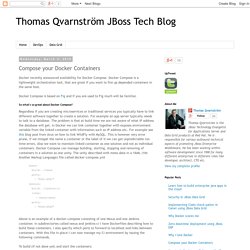
Docker Compose is a lightweight orchestration tool, that are great if you want to fire up depended containers in the same host. Docker Compose is based on Fig and if you are used to Fig much will be familiar. Regardless if you are creating microservices or traditional services you typically have to link different software together to create a solution. For example an app server typically needs to talk to a database. The problem is that at build time we are not aware of what IP address the database will get. Nexus: build: . Above is an example of a docker-compose consisting of one Nexus and one Jenkins container. To build (if not done yet) and start the containers: The Road To Awesome - Welcome JBoss Champions Program ~ Enterprise Software Development with Java.
Jboss. Adam BienConsultant and author Adam Bien is an Expert Group member for the Java EE 6 and 7, EJB 3.X, JAX-RS, and JPA 2.X JSRs.

He has worked with Java technology since JDK 1.0 and with Servlets/EJB 1.0 and is now an architect and developer for Java SE and Java EE projects. He has edited several books about JavaFX, J2EE, and Java EE, and he is the author of Real World Java EE Patterns—Rethinking Best Practices and Real World Java EE Night Hacks—Dissecting the Business Tier. Tools - Docker and WildFly Part 1 - Deployment via Docker volumes. These images are JBoss' standard Docker images and they do not expose more features than just the bare minimum for production and reuse.
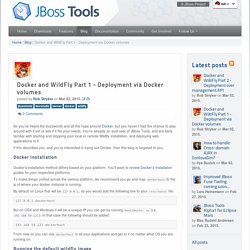
This first blog will show how to use them as-is, but going forward we will show how to configure them to be a bit more useful for development use cases. To make sure your docker installation has worked, and that Wildfly can start without any errors, you can do the following: docker run -it -p 8080:8080 jboss/wildfly This command will run the Docker image for jboss/wildfly in its default state, no customizations and map port 8080 on your dockerhost to 8080 of the running jboss/wildfly container. Once this is run, the command will not only start up your container, but also launch the server in standalone mode, and connect a terminal to it so you can see the output. Assuming you see the console output, and the server runs with no errors and you can access the welcome browser via dockerhost then you’re set up and ready for the next step.
Jiri Folta sur Twitter : "If I were a #java #developer, where would I hide myself? @RedHatJobs for #JBoss and #WildFly! ping me if interested! How fast is logging? I ran the same benchmark set several times with a different OptaPlanner logging level: All other libraries (including Drools) were set to warn logging.
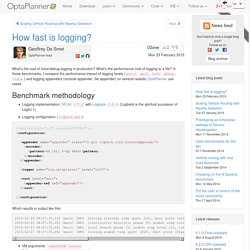
The logging verbosity of OptaPlanner differs greatly per level: error and warn: 0 lines info: 4 lines per benchmark, so less than 1 line per minute. Debug: 1 line per step, so about 1 per second for Tabu Search and more for Late Acceptance trace: 1 line per move, so between 1k and 120k per second These are the raw benchmark numbers, measured in average score calculation count per second (higher is better): I’ll ignore the difference between error, warn and info logging: The difference is at most 4%, the runs are 100% reproducible and I didn’t otherwise use the computer during the benchmarking, so I presume the difference can be blamed on the JIT hotspot compiling or CPU luck. What does turning on Debug or Trace logging cost us in performance (versus Info logging)? Markus Eisele sur Twitter : "[blog] JBoss Forge NetBeans integration - Getting Started #Forge #Jboss #netbeans.
JBoss Forge NetBeans integration - Getting Started ~ Enterprise Software Development with Java. Markus Eisele sur Twitter : "[blog] Byteman - a swiss army knife for byte code manipulation #Byteman #Jboss. Byteman - a swiss army knife for byte code manipulation ~ Enterprise Software Development with Java. I am working with a bunch of communities in JBoss and there is so much interesting stuff to talk about, that I can't wrap my head around every little bit myself.

This is the main reason why I am very thankful to have the opportunity to welcome guest bloggers here from time to time. Today it is Jochen Mader, who is part of the nerd herd at codecentric. Red Hat Customer Portal. ShrinkWrap Descriptors Docker 1.0.0-alpha-2 Released · Arquillian Blog. The Arquillian team is proud to announce the 1.0.0-alpha-2 release of the ShrinkWrap Descriptors Docker component!
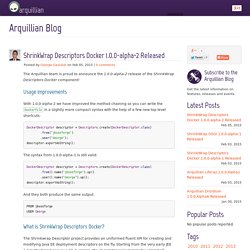
Usage improvements With 1.0.0-alpha-2 we have improved the method chaining so you can write the Dockerfile in a slightly more compact syntax with the help of a few new top level shortcuts: DockerDescriptor descriptor = Descriptors.create(DockerDescriptor.class) .from("jbossforge") .user("George"); descriptor.exportAsString(); Setting up a JBoss EAP 6 cluster with Apache mod_cluster - load balancing & failover. In this blog I will look to recreate the system created in Part One but using JBoss EAP 6.
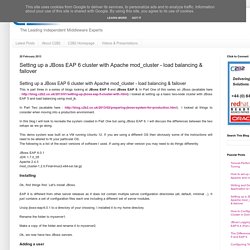
I will discuss the differences between the two setups as we go along. This demo system was built on a VM running Ubuntu 12. If you are using a different OS then obviously some of the instructions will need to be altered to fit your particular OS. The following is a list of the exact versions of software I used. If using any other version you may need to do things differently. Jboss-eap-quickstarts/cluster-ha-singleton at 6.4.x-develop · jboss-developer/jboss-eap-quickstarts. Cluster-ha-singleton - fbricon's library. Load Balancing EJBs in WildFly. Load Balancing EJBs in WildFly One of the main advantages of using clustered Session Beans is that load can be spread across several cluster members.

This by default happens on a random basis. Today we will learn how to customize the Session bean load balancing in WildFly or JBoss EAP 6. By default, calls from a client to a cluster of Stateless Session Beans (SLSB) will be distributed among the SLSBs in a random like behavior. Things are different in case you are using Stateful EJBs (SFSB) and this is discussed in the next part of the article. As you can see from the following image, before Clustering enters in the picture, when an EJB is invoked a Deployment Node Selector is used to choose a corresponding EJB receiver for an eligible server instance that can handle the EJB invocation. The default node selector is a RandomNode Selector. EAP - Downloads. To download JBoss EAP you must have an account.
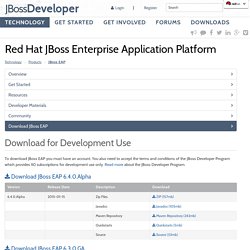
You also need to accept the terms and conditions of the JBoss Developer Program which provides $0 subscriptions for development use only. Read more about the JBoss Developer Program. View Older Downloads. Java EE with NetBeans on OpenShift. Little's Blog: Open source trends talk. A few weeks ago I have the privilege of giving the keynote at OpenSlava 2014.
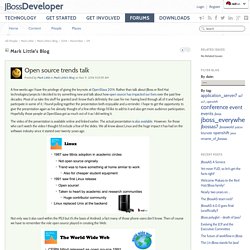
Rather than talk about JBoss or Red Hat technologies/projects I decided to try something new and talk about how open source has impacted our lives over the past few decades. Most of us take this stuff for granted and I know that's definitely the case for me: having lived through all of it and helped participate in some of it, I found pulling together the presentation both enjoyable and a reminder. I hope to get the opportunity to give the presentation again as I've already thought of a few other things I'd like to add to it and also get more audience participation. Hopefully those people at OpenSlava got as much out of it as I did writing it. The video of the presentation is available online and linked earlier.
Not only was it also used within the PS3 but it's the basis of Android, a fact many of those phone users don't know. And for those in the audience who didn't know, the gopher is from Caddyshack! Monitoring a cluster using WildFly API. Monitoring a cluster using WildFly API WildFly 8 introduces a new API which can be used to gather information about the WildFly cluster topology and receive notifications when new nodes leave or join the cluster.
The org.wildfly.clustering.group.Group interface can be used for this purpose: The Group service provides a mechanism to view the cluster topology and to be notified when the topology changes. You can monitor both a JGroup channel and a Cache group. The purpose of this tutorial will be to monitor JGroups channels. Write in Ceylon, deploy as OSGI, use in Java EE. ... or how to use Ceylon inside Java EE application servers. The Ceylon language is inherently modular, and is shipped with a complete infrastructure that allows leveraging this modularity out-of-the box. However Ceylon is not captive of its own infrastructure. After the Java and JS interoperability efforts, the 1.1.0 version has brought out-of-the-box compatibility with OSGI, which enables running Ceylon code inside many other containers.
Every module archive produced by the Ceylon compiler contains OSGI headers in its MANIFEST file, that describe the module as it should seen by OSGI containers. Containers tested so far are: Docker Hub Registry - Repositories of Docker Images. This is an example Dockerfile with WildFly application server. Usage To boot in standalone mode. Openshift-cartridges/openshift-jrebel-cartridge. Ceylon: Ceylon 1.1.0 is now available. Ten whole months in the making, this is the biggest release of Ceylon so far! Ceylon 1.1.0 incorporates oodles of enhancements and bugfixes, with well over 1400 issues closed. Ceylon is a modern, modular, statically typed programming language for the Java and JavaScript virtual machines. The language features a flexible and very readable syntax, a unique and uncommonly elegant static type system, a powerful module architecture, and excellent tooling, including an awesome Eclipse-based IDE.
Ceylon enables the development of cross-platform modules that execute portably in both virtual machine environments. Java EE 7, JBoss, WildFly, Devoxx4Kids, and Parties at JavaOne 2014. JBoss EAP / Wildfly Management Interfaces and Clients. The JBoss EAP / Wildfly provides a powerful concept for management, configuration, and monitoring of the application server itself and its Java EE applications. In the previous post we focused on some useful runtime metrics, which are of interest when monitoring your application server and applications.
This post introduces the management clients provided by the JBoss EAP / Wildfly Application Server to manage and configure server instances. Regardless which client you choose to manage your server instances, all changes are persistent in the XML configuration file with a consistent state and, as fallback, all changes are versioned in the configuration history directory of the application server. By default all remote connections are secured. The management concept is based on the detyped management API. Command Line Interface (CLI) The Command Line Interface (CLI) is the most powerful management client to manage domain and standalone server. CLI scripting. Docker and JBoss - the perfect combination - Virtual JBoss User Group (Newcastle Upon Tyne, England) 1) Watch live on YouTube 2) Join the discussion and ask questions in the Web Chat This is a virtual Meetup so timezones are 6PM BST / 5PM UTC / 1PM EDT / 10 AM PDT.
Thomas Qvarnström JBoss Tech Blog: How to do Continuous Delivery with JBoss EAP. Together with a colleague, Siamak Sadeghianfar, we have created a demo of a Continuous Delivery environment. The demo uses Docker container to simulate different host running Nexus, Jenkins, Sonar etc. In the demo Jenkins will listen for new commits from a Java EE project called TicketMonster on Github and build a deployable WAR file using Nexus.
Developer Interviews (#DI 1) @ehsavoie about #WildFly and #NetBeans. Java EE, WildFly and JBoss at Upcoming Conferences. Christian Posta — Software Blog. Securing access to JBoss-WildFly Management console - jboss security. ModeShape 4.0.0.Alpha4 is available. JBoss Tools Community Acceptance Testing (JBoss Tools CAT) JBoss Tools is a set of plugins for Eclipse that complements, enhances and goes beyond the support that exists for JBoss and related technologies in the default Eclipse distribution. Until now, early builds of JBoss Tools were released at a regular cadence leading up to the release of a particular version. Anybody could download, integrate the plugins in Eclipse, test, and provide feedback.
Red Hat JBoss Enterprise Application Platform. Weekly Editorial: This week in JBoss (March 6th... Interview with WildFly Lead Jason Greene on WildFly 8. Red Hat's JBoss division has today announced the availability of WildFly 8, the product formerly know as JBoss Application Server, as we reported elsewhere. DevConf.cz. Weekly Editorial: This week in JBoss (23rd of J... It has been some time since we have had a chance to chat and update you on all the JBoss goodness that has been cooking up behind the scenes here since the New Year started. Time we fixed that, so without further delay, we bring you several weeks of news from the JBoss communities. Events. Role Based Access Control in WildFly 8 (Tech Tip #12) Role Based Access Control (RBAC) is the ability to restrict access to system or certain portions of it to authorized users.
Phasenraum2010/javaee7-petclinic. WildFly 8 Book. Chapter 1: Installation What is new in WildFly 8? Installing WildFly 1A look into the application server file system Starting WildFly Your first task: create an user to manage WildFly Stopping Wildfly Installing WildFly as Service Chapter 2 Core Server configuration The two available server modes Understanding the server configuration file Configuring WildFly in Standalone mode Configuring WildFly in Domain mode Choosing between standalone mode and domain mode Managing the WildFly domain Chapter 3 Deploying applications File system deployment Deploying using the Web interface Deploying the application using the CLI Deploying applications using Maven.
Open Source Conference Amsterdam 2013 - JBoss Integration & BPM in the house. Deep dive into Wildfly 8 and Java EE 7. Megadeth - Burning Bridges - Live - Rude Awakening. Several Architectural Styles with Java EE 7. ModeShape 3.6.0.Final is available. AdamBien : At #jboss #onedaytalk talking... OpenShift Primer - a JBoss workshop coming soon to JAX London 2013.
Welcome to “Miles to go” 2.0. HornetQ gource history. Server Side Web Frameworks, The Last Stand. Speakers & Videos. Higgs boson scientists win Nobel prize in physics. Red Hat to Present Platform-as-a-Service Technology Update During Live Webcast on September 24, 2013. Jeromepetit : Deploy Google AppEngine at... Weekly Editorial: This week in JBoss (5th Septe... 8.0.0.Alpha4 Release Notes. Immutant 1.0.0 Released (Finally!) JBoss Community Recognition Awards. Hasalex/eap-build. Immutant 1.0.0.cr1 Released. Our Maven Dependency Resolver Goes 2.0.0 Final. NetBeans 7 + JBoss 7 = Productive Combo. RHQ 4.8 released. JDBC datasource password encryption in JBoss AS7. ModeShape with AS7 example application - Modeshape. Little's Blog: EE7 is approved. Creating a delegating login module (for JBoss EAP 6.1) Little's Blog: EE7 launch announcement.
Create a JBoss AS 7 appliance with VirtualBox - jboss configuration. Setting-up a High Available Tuned Java EE environment using JBoss EAP6. First CapeDwarf Release! Jeff Mesnil — WildFly Application Server. Creating a delegating login module (for JBoss EAP 6.1)